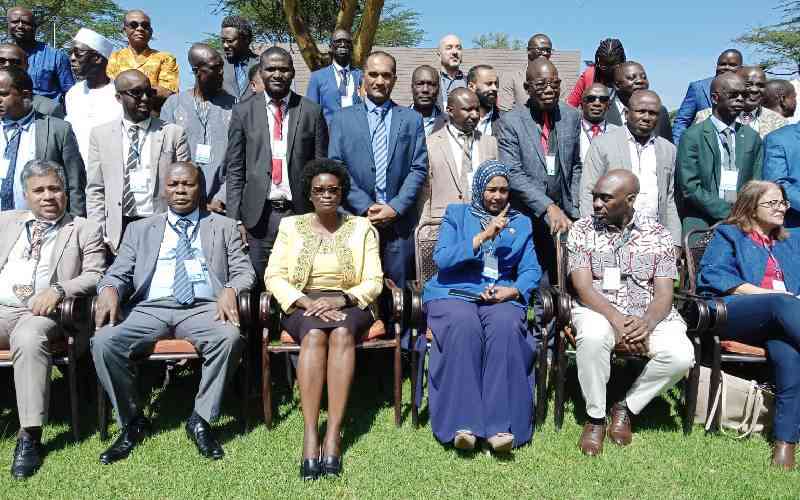Changing climatic conditions, a balooning population and dwindling resources continue to pose challenges in Kenya’s efforts towards food sufficiency.
The latest report of the Famine Early Warning Systems Network (Fewsnet) classifies over 70 percent of Kenya as highly food insecure.
Both Government and non-government organisations have been looking for strategies that can move us towards ensuring availability and access to food for all. This is why yesterday’s announcement that Kenya is among eight African countries that will benefit from a Sh1.5 billion grant from the Bill and Melinda Gates Foundation is welcome news.
We applaud the move because it not only targets small-scale women farmers but also uses simple technology that is aimed at doubling yields of grains and legumes.
Women account for 80 percent of Africa’s farmers and most agriculture programmes that are implemented in the continent fail because they ignore their input.
The programme dubbed "For Africa" recognises that due to land overuse in most parts of Africa -— where arable land is limited and shrinking — the nitrogen fixing bacteria is not present in the soil due to lack of phosphorous. So the farmers who will benefit from this grant will be helped to introduce bacteria that would in turn increase nitrogen nutrients in the soil. Research shows that this simple procedure leads to the doubling of grain and legume yields.
Perennial Famine
The Gates grant is only one of the food security interventions. We need more of such results-oriented strategies and interventions to steer the country away from perennial famine.
Whearas a bit of research and innovation may be required to improve yields and help ease production costs, most of what needs to be done has really been done by other countries and with fantastic results. We don’t need to re-invent the wheel.
We have, for example, continued to rely on rain-fed agriculture which is becoming riskier by the day as the realities of climate change dawn on us.
Although more acreage has been put under irrigation in the Hola irrigation scheme, a clear strategy on irrigation needs to be rolled out to reach as many farmers as possible. Irrigation schemes may not resolve the problem of food insecurity so long as the small scale farmer continues to rely on rain and use poor seed in poor soil.
Plans must be worked out to rope in small-scale farmers into the realm of irrigation and the use of modern technology like greenhouses.
For this to be done, we have to ensure sustainable management of water resources and increase our forest cover.
Over-reliance on maize as the staple food has also worked against efforts to attain food sufficiency. Fewsnet for example, points out that the marginal agricultural areas of the coast and south-eastern Kenya have continued to grow maize in an agro ecology more suited to drought-tolerant crops such as millet, sorghum and cowpeas. As a result, farmers have experienced a succession of crop failures even when rains would have been sufficient for drought-tolerant crops.
National Diet
Stay informed. Subscribe to our newsletter
There is need to diversify the national diet to other grains like rice to ease the pressure on maize. The move by Government to provide funds for fish dams in every constituency in its stimulus plan will go a long way towards enriching the national diet and diversify fish sources.
Lastly pastoralism in its current form is unsustainable. It relies on poor breeds of animals and unpredictable pastures and water sources.
The Ministry of Livestock must come up with strategies that would radically alter beef production to make it more profitable, reliable and predictable.
Only by implementing such measures will we become food sufficient.
 The Standard Group Plc is a
multi-media organization with investments in media platforms spanning newspaper
print operations, television, radio broadcasting, digital and online services. The
Standard Group is recognized as a leading multi-media house in Kenya with a key
influence in matters of national and international interest.
The Standard Group Plc is a
multi-media organization with investments in media platforms spanning newspaper
print operations, television, radio broadcasting, digital and online services. The
Standard Group is recognized as a leading multi-media house in Kenya with a key
influence in matters of national and international interest.
 The Standard Group Plc is a
multi-media organization with investments in media platforms spanning newspaper
print operations, television, radio broadcasting, digital and online services. The
Standard Group is recognized as a leading multi-media house in Kenya with a key
influence in matters of national and international interest.
The Standard Group Plc is a
multi-media organization with investments in media platforms spanning newspaper
print operations, television, radio broadcasting, digital and online services. The
Standard Group is recognized as a leading multi-media house in Kenya with a key
influence in matters of national and international interest.








